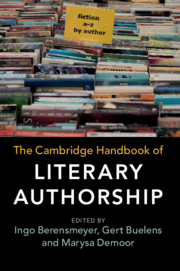Book contents
- The Cambridge Handbook of Literary Authorship
- The Cambridge Handbook of Literary Authorship
- Copyright page
- Contents
- Figures
- Contributors
- Acknowledgments
- Abbreviations
- Chapter 1 Introduction
- Part I Historical Perspectives
- Part II Systematic Perspectives
- Part III Practical Perspectives
- Select Bibliography
- Index
Part III - Practical Perspectives
Published online by Cambridge University Press: 07 June 2019
- The Cambridge Handbook of Literary Authorship
- The Cambridge Handbook of Literary Authorship
- Copyright page
- Contents
- Figures
- Contributors
- Acknowledgments
- Abbreviations
- Chapter 1 Introduction
- Part I Historical Perspectives
- Part II Systematic Perspectives
- Part III Practical Perspectives
- Select Bibliography
- Index
Summary
The matter of attribution has to do with identifying the author (or even the most likely candidates) for a text whose authorship is doubtful, collaborative, or unknown. Such work has been practiced down the centuries, most often for the rectification of literary history but also in political and theological disputation where the authenticity of a document is at issue. Its apparent value in legal inquiry is limited by the fact that few criminals offer a substantial corpus of their writings. The notorious US Unabomber, who might well have written himself into gaol without benefit of other evidence, was a striking exception.
- Type
- Chapter
- Information
- The Cambridge Handbook of Literary Authorship , pp. 323 - 443Publisher: Cambridge University PressPrint publication year: 2019

